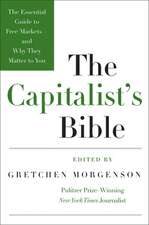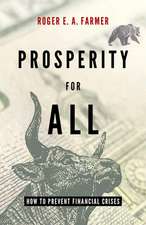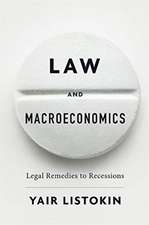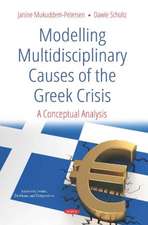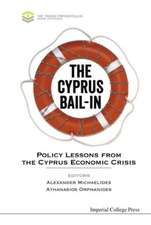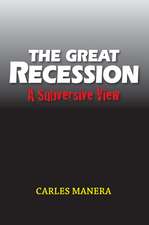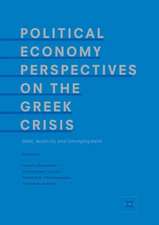These Are the Plunderers: How Private Equity Runs—and Wrecks—America
Autor Gretchen Morgenson, Joshua Rosneren Limba Engleză Paperback – 5 iun 2024
Pulitzer Prize–winning and New York Times bestselling financial journalist Gretchen Morgenson and financial policy analyst Joshua Rosner investigate the insidious world of private equity in this “masterpiece of investigative journalism” (Christopher Leonard, bestselling author of Kochland)—revealing how it puts our entire economy and us at risk.
Much has been written about the widening gulf between rich and poor and how our style of capitalism has failed to provide a living wage for so many Americans. But nothing has fully detailed the outsized role a small cohort of elite financiers has played in this inequality. Pulitzer Prize–winning journalist and bestselling author Gretchen Morgenson, with coauthor Joshua Rosner, unmask the small group of celebrated Wall Street financiers, and their government enablers, who use excessive debt and dubious practices to undermine our nation’s economy for their own enrichment: private equity.
These Are the Plunderers traces the thirty-year history of corporate takeovers in America and private equity’s increasing dominance. Morgenson and Rosner investigate some of the biggest names in private equity, exposing how they buy companies, load them with debt, and then bleed them of assets and profits. All while prosecutors and regulators stand idly by.
The authors show how companies absorbed by private equity have worse outcomes for everyone but the financiers: employees are more likely to lose their jobs or their benefits; companies are more likely to go bankrupt; patients are more likely to have higher healthcare costs; residents of nursing homes are more likely to die faster; towns struggle when private equity buys their main businesses, crippling the local economy; and school teachers, firefighters, medical technicians, and other public workers are more likely to have lower returns on their pensions because of the fees private equity extracts from their investments. In other words: we are all worse off because of private equity.
These Are the Plunderers is a “meticulous and devastating takedown of a powerful force in Western capitalism” (Brad Stone, bestselling author of Amazon Unbound) that exposes the greed and pillaging in private equity, revealing the many ways these billionaires have bled the economy, and, in turn, us.
| Toate formatele și edițiile | Preț | Express |
|---|---|---|
| Paperback (1) | 83.44 lei 3-5 săpt. | +14.96 lei 6-12 zile |
| Simon&Schuster – 5 iun 2024 | 83.44 lei 3-5 săpt. | +14.96 lei 6-12 zile |
| Hardback (1) | 179.30 lei 3-5 săpt. | |
| Simon&Schuster – 21 iun 2023 | 179.30 lei 3-5 săpt. |
Preț: 83.44 lei
Nou
Puncte Express: 125
Preț estimativ în valută:
15.97€ • 16.65$ • 13.27£
15.97€ • 16.65$ • 13.27£
Carte disponibilă
Livrare economică 28 februarie-14 martie
Livrare express 13-19 februarie pentru 24.95 lei
Preluare comenzi: 021 569.72.76
Specificații
ISBN-13: 9781982191290
ISBN-10: 1982191295
Pagini: 416
Ilustrații: 8-pg 4-c insert
Dimensiuni: 140 x 213 x 25 mm
Greutate: 0.36 kg
Editura: Simon&Schuster
Colecția Simon & Schuster
ISBN-10: 1982191295
Pagini: 416
Ilustrații: 8-pg 4-c insert
Dimensiuni: 140 x 213 x 25 mm
Greutate: 0.36 kg
Editura: Simon&Schuster
Colecția Simon & Schuster
Notă biografică
Gretchen Morgenson is the senior financial reporter for the NBC News Investigative Unit. A former stockbroker, she won the Pulitzer Prize in 2002 for her “trenchant and incisive” reporting on Wall Street. Previously at The New York Times and The Wall Street Journal, she and coauthor Joshua Rosner wrote the New York Times bestseller Reckless Endangerment: How Outsized Ambition, Greed, and Corruption Led to Economic Armageddon about the mortgage crisis.
Joshua Rosner is managing director at independent research consultancy Graham Fisher and Co., advising regulators, policymakers, and institutional investors on banking and financial markets. He has been interviewed on PBS, CBS, NBC, CNN, Bloomberg, CNBC, and Fox News, and featured in or written for The New York Times, The Wall Street Journal, Reuters, Economist, Barron’s, and HuffPost. Joshua is the coauthor of the New York Times bestseller Reckless Endangerment with Gretchen Morgenson.
Joshua Rosner is managing director at independent research consultancy Graham Fisher and Co., advising regulators, policymakers, and institutional investors on banking and financial markets. He has been interviewed on PBS, CBS, NBC, CNN, Bloomberg, CNBC, and Fox News, and featured in or written for The New York Times, The Wall Street Journal, Reuters, Economist, Barron’s, and HuffPost. Joshua is the coauthor of the New York Times bestseller Reckless Endangerment with Gretchen Morgenson.
Extras
Chapter One: “Pizza the Hut”: Leon Black and the Art of the FleeceCHAPTER ONE “Pizza the Hut” Leon Black and the Art of the Fleece
Katie Watson was a brown-eyed toddler in Phoenix, Arizona, beloved by her family for her sunny, easygoing ways. In 1982, when she was not yet two, Katie had become permanently brain damaged, after a local hospital failed to treat her pneumonia properly. Her parents, Vince and Sue Watson, received a medical malpractice award in a lawsuit against the hospital and, directed by the court, invested part of it in a guaranteed insurance company contract. The investment promised to deliver a monthly stream of income to Katie to cover expenses for her care.
That court overseeing the Watsons’ case steered them to buy a product issued by the Executive Life Insurance Company, then rated A+ for financial soundness—the highest grade an insurer could receive. Under the arrangement, known as a structured settlement, Executive Life, California’s largest insurer, contracted to pay $9,000 a month, with a cost-of-living adjustment, for as long as Katie lived. The funds would cover round-the-clock care for Katie at home, and after a trial and settlement with the hospital, the Watsons started receiving the insurer’s payments in 1986.
Four years later, Executive Life was teetering. Its investment portfolio had cratered amid a bond market meltdown, and the California insurance commissioner seized it in the spring of 1991. Then the commissioner sold the insurer’s investment portfolio in a virtual giveaway to a New York financier and his partners, claiming the deal would benefit policyholders. Not exactly: Katie’s “guaranteed” contract with Executive Life—and the payments it had promised—was no longer in force. Under the vastly reduced terms of the new post-takeover policy, her parents could not afford the costs of Katie’s care, expenses they would now have to shoulder themselves. Unable to pay the mortgage on their home, they lost it to foreclosure. Katie, who passed away in 2017, wound up receiving millions of dollars less than Executive Life had promised to pay for her care and support.
Executive Life had over three hundred thousand policyholders, many of whom relied on it for regular payments. Like Katie, these customers took a serious hit after the company was seized and its assets sold in a deal engineered by the New York financier. A 2008 audit of the deal by the state of California tallied policyholder losses at over $3 billion, a figure that is probably low.
Which New York titan of finance won control of Executive Life’s deeply discounted assets all those years ago? Leon Black, cofounder of Apollo Global Management and a billionaire many times over. Today he enjoys a sumptuous art collection, an array of palatial homes, and, until recently, a seat of power on the prestigious Museum of Modern Art board.
The multibillion-dollar bonanza known as Executive Life was the very birth of Black’s fortune. In 1991, when he snared it, Black’s new partnership, Apollo, had just been born. Running from the implosion of his former employer, a felonious brokerage firm known as Drexel Burnham Lambert, Black managed to wrangle the Executive Life assets on the cheap, for roughly 50 cents on the dollar.
Some called it “the deal of the century.” Later, the transaction would come under federal prosecutors’ scrutiny and Black would be named as a defendant in a California attorney general’s conspiracy suit related to it. But that case, alleging secret arrangements that cheated the state and Executive Life policyholders, was dismissed on a technicality—the judge ruled that the AG had no standing. Black walked away with his gains.
Thirty years later, the Executive Life transaction is long forgotten. In 2021, a California court approved the state insurance department’s request to destroy all documents detailing the failure, saying that the matter was closed because policyholders had finally received their last payouts. The document destruction started in early 2022.
Still, the deal is rich for reexamination. Why? Because it is Exhibit A for the kinds of financial engineering and exploitation that have led to the elevation of wealthy financiers and the degradation of other stakeholders over the last three decades. In fact, Black’s takeover of Executive Life’s assets is a Rosetta stone for how a small group of aggressive moneymen have extracted the wealth and treasure of the American middle class, working poor, and retirees since the late 1980s.
The Executive Life transaction stands out as a harbinger of the destruction to come in another way. In recent years, these same financiers have begun acquiring insurance companies outright, putting current policyholders at risk of losses from questionable investments, all the while generating enormous fees for themselves. Many policyholders don’t even know their futures lie in the plunderers’ hands or that the historically conservative assets that used to back their insurance and retirement policies have been replaced by those that carry far more risk.
But we’re getting ahead of ourselves. First, consider the winners and losers in the long-ago Executive Life deal: the transaction made billions for Black and his partners, almost overnight, at the expense of retirees, pensioners, and the disabled. All were Executive Life policyholders, like Katie Watson, who’d been promised payouts or end-of-life benefits. They wound up forfeiting money as a result of the deal that Black and his partners dreamed up.
Second, even though the Black-led sale of the insurance company and its assets was overseen by a California court charged with ensuring fairness, many aspects of the deal were cloaked in secrecy and riddled with conflicts of interest unknown to policyholders. This, too, was a precursor to the present day; conflicts and secrecy—even in a judicial system that is supposed to be transparent for the public good—are key features of the private equity playbook, enabling them to put themselves and their interests ahead of workers, pensioners, and investors.
Had the Executive Life policyholders and their advocates known about the conflicts and hidden relationships, they could have agitated for a better deal. For example, if policyholders had known Black and his partners were already investors in some of the bonds they acquired in the Executive Life takeover, the policyholders could have demanded higher prices from Black for those bonds.
But the man representing the Executive Life policyholders in the deal, who was obliged to get the best possible outcome for them, was no typical seller. He was the California insurance commissioner, an ambitious politician named John Garamendi. He gave Black the Executive Life prize, claiming then and forevermore that policyholders did well in the deal. After several unsuccessful runs for California governor, in 2009 Garamendi became a congressman, a Democrat who today represents the state’s eighth district, northeast of San Francisco.
Wealth transfers like the Executive Life deal, where the assets of everyday Americans wind up in the hands of cunning financiers, are often blessed by government officials. Indeed, regulatory complicity or complacency has been crucial to the successes of these elites over the decades.
More than a decade after the deal occurred, federal prosecutors contended it was infected with fraud. A foreign company, affiliated with Black’s group, that purchased the insurer had unlawfully concealed its ownership stake. Although the United States Justice Department went after some of Black’s associates in the transaction, and California’s attorney general named him as a defendant in its conspiracy case, Black, the mastermind, was never found culpable.
Another recurring aspect of the plunder years.
Katie Watson’s parents had tried to fight the sale of the insurer’s assets to Black’s new partnership. They’d traveled to Los Angeles to attend court hearings and argued against the sale with the insurance commissioner on the courthouse steps. None of it did any good.
Today, Vince and Sue Watson are still angry that money pledged for their daughter’s care wound up in Leon Black’s pocket.
“Leon Black got the deal of the century on the backs of the handicapped and the brain-damaged,” Sue Watson told us. “Over the years, we tracked him and saw how he thrived with our money. Wow is all I can say. Wow.”
Seeing Black pick the Executive Life carcass clean in the early 1990s was only the beginning, Sue Watson recounted. In the years that followed, she and her husband watched as he rose to dazzling wealth and status in New York City, amassing all the trappings. There was the private jet, the yacht, the real estate holdings in the Hamptons, Los Angeles, London, Westchester County horse country, and Manhattan’s Upper East Side.
And the art! Black’s prodigious collection included a Raphael, a famed Picasso sculpture, and the only privately held copy of The Scream by Edvard Munch. One of the most iconic images in all of art, Black purchased it for $120 million in 2012.
Six years later, Black ascended to the chairmanship of the Museum of Modern Art, founded by Rockefellers. He and his wife Debra gave $40 million to the museum, which named its film center for the couple. Black’s fortune stood at $7 billion in 2018, according to Forbes magazine.
Black’s climb to the pinnacle of New York City society had not been preordained. Yes, he had been raised the son of Eli Black, a former corporate CEO known for his contributions to the arts in New York City. But tragedy struck the family in February 1975, when Black, the chief executive of a conglomerate called United Brands, committed suicide just as his involvement in a significant international corporate bribery scandal was about to emerge. Weeks after the executive used his briefcase to smash a window of his forty-fourth floor Midtown office and jumped to his death, a federal investigation began. Its conclusion: Eli Black had authorized bribes to officials in Honduras to reduce his company’s taxes. In addition to taking down the president of Honduras, the fraud helped produce a new law banning such payoffs—the Foreign Corrupt Practices Act of 1977.
The suicide occurred while Leon Black was finishing up at Harvard Business School. After graduating from Dartmouth with a degree in philosophy and history, he had decided to pursue a career in finance like his father. But despite obtaining his MBA from Harvard, he’d been turned down for a job at Lehman Brothers, then a prestigious investment bank at which his father had worked. Black went instead to an unglamorous accounting firm, quit after a year, and joined an obscure financial publisher called Boardroom Reports.
It was not an auspicious beginning. But soon Black secured a position at Drexel Burnham Lambert, a second-tier Wall Street firm known for being scrappy and brash. There he earned the nickname “Pizza the Hut” for his voracious appetite when toiling to meet deadlines on mergers and acquisitions deals.
Black would rise at Drexel and the firm would make him rich. But it would also emotionally scar him when it collapsed in 1990 amid a massive insider trading and market manipulation scandal. Beyond that, Black emerged from Drexel relatively unscathed, as he would in subsequent brushes with controversy.
Until, that is, the stunning details of his relationship with Jeffrey Epstein, the notorious pedophile, began to emerge in 2019.
Epstein was a Manhattan arriviste and man about town who claimed to be a financial advisor. His credentials were nonexistent—a five-year stint as a trader at Bear Stearns in the 1970s was the sum total of his Wall Street cred. Black had gotten to know him in the 1990s, their relationship involving many mutually beneficial lofty positions and rewards. Black invited Epstein in 1997 to become a director of the Black family foundation. Two years after that, an Apollo executive donated $167,000 to a foundation associated with Epstein.
In the years after Epstein pleaded guilty to procuring a child for prostitution in June 2008, the ties between the men grew stronger. In 2011, an Epstein investment unit bought a large stake in Environmental Solutions Worldwide, a small company funded by Black and where two of his sons served as directors. And when Apollo offered shares of its own stock to the public for the first time in 2011, an Epstein entity based in the United States Virgin Islands bought $5 million worth of shares.
Next came a $10 million donation in 2015 by Black to an Epstein foundation called Gratitude America. This time, Black was careful to make his contribution through a limited-liability company he controlled that did not bear his name, the Wall Street Journal reported.
But after Epstein died in a Manhattan jail accused of sex trafficking in 2019, truly startling facts began to materialize about Black’s decades-long association with the pedophile. In the spring of 2021, a bombshell internal Apollo investigation determined that Black had been paying Epstein millions of dollars for financial advice even after Epstein’s 2008 prosecution. Over a period of five years, Black paid Epstein an astonishing $158 million; among the advice Epstein provided was how Black could lower his tax bills.
Given that Epstein was nobody’s idea of a tax guru, Black’s huge payments were puzzling. They also turned out to be a career-ender, because they imperiled Apollo’s ability to raise money from public pension funds and other big investors. These buyers were Apollo’s biggest and most profitable clients; if they turned from the firm because of the Epstein taint, its business model would collapse.
In January 2021, at the age of sixty-nine, Black finally lost his grip on Apollo, the firm he’d founded. Black said he was retiring from Apollo for health reasons, but the Epstein stigma also triggered his resignation two months later as chairman of the Museum of Modern Art. If that weren’t enough, a former fashion model who had been his mistress soon came forward with tales of rape, sexual harassment, and abuse by Black, beginning in 2008. A second accuser filed suit against Black, contending he had raped her.
The titan fought back, denying both allegations and contending that the relationship with the Russian woman, more than thirty years his junior, had been “consensual.” He also said she’d tried to extort money from him and that he’d paid her $9 million to keep their affair quiet. Her claim that Black had flown her to Palm Beach to try to get her to bed Epstein and Black simultaneously was fiction, Black contended. As this book went to press, both cases were ongoing.
The sordid stories, gleefully retold in New York’s gossip columns, rocked Black.
But in the upside-down world of Wall Street, Black’s departure from Apollo only served to increase his wealth. The firm’s shares—of which he still holds millions—rose when he left. It was as if investors were relieved there’d be no more bruises for the firm with him gone.
As Black departed Apollo and the MOMA board, an aroma of disgrace filled the air. Encomiums from his peers were few upon his exit from the A-list scene. Now Black’s eventual obituary would not simply recount his remarkable rise, his accumulation of vast wealth, and amazing art—it would also document his fall.
To Sue Watson, Black’s woes were only fitting, a case of “what goes around comes around.” Karma has everyone’s address, they say.
Memories are famously short on Wall Street. But for some with longer recall, Black’s ouster from Apollo over payments to Jeffrey Epstein for tax advice had a riveting parallel.
Forty-five years earlier, Black’s father, Eli, had been undone by a secret scheme involving his company’s taxes. A corporate takeover artist and chief executive of United Brands, a large conglomerate, the elder Black had orchestrated two bribes to reduce banana export taxes his company owed. With the scandal about to emerge, he killed himself in February 1975.
Leon Black was by no means a carbon copy of his father—hardly anybody is. But the men’s business methods had striking similarities—the heavy debt used to acquire companies, the predilection for sharp tactics, the view that companies were little more than a collection of numbers. Each man has been characterized as “a pirate.” Decades after his father’s suicide, when Leon Black was at the pinnacle of his career, an interviewer asked him about the calamity. His response was telling. “It took me years of therapy to get over that,” he said, “and to figure out where he ended, and I began.”
Elihu Menasche Blachowitz was an ordained rabbi with a financial acumen. Born in Poland, he emigrated with his family to New York as a child and graduated from Yeshiva University in 1940. As a rabbi, he led a congregation in Long Island but saw opportunity on Wall Street, becoming an investment banker at Lehman Brothers and later at the now defunct American Securities.
Son Leon was born in 1951 and three years later, Eli Black became CEO of American Seal-Kap, a bottle cap manufacturer. Eli had been advising the company on financial matters while a banker at American Securities, but Seal-Kap wanted him and his expertise in-house.
As CEO, Black soon started buying other companies to bring into the American Seal-Kap fold and piling on debt to do so. His most significant purchase was the United Fruit Company, a storied and notorious banana importer founded in 1899 and based in Boston.
Once a mighty, neocolonialist enterprise founded by slave traders, United Fruit controlled massive landholdings in Central America, along with a vast fleet of ships and railroad operations. The nation’s largest banana importer, United Fruit had close government connections; it played a role in the 1961 Bay of Pigs fiasco, a CIA operation that tried and failed to invade Cuba. United Fruit supplied two ships from its so-called Great White Fleet for the ill-fated invasion, according to An American Company: The Tragedy of United Fruit, by Thomas P. McCann, a former vice president of the company.
In 1968, United Fruit was facing higher costs of growing and exporting bananas, a major problem given that the company did nothing else. At the helm of American Seal-Kap, Black started quietly buying up United Fruit stock in the open market, with the help of an allied brokerage firm, amassing a controlling stake of 733,000 shares. In McCann’s telling, the way Black cobbled together the shares may have run afoul of securities rules and led to questions from other United Fruit shareholders as well as the Federal Trade Commission.
But these questions became moot when Black proposed a takeover to the company’s directors; initially dubious, all but one agreed to the deal when no other reasonable suitor materialized.
Wall Street approved and United Fruit’s stock soared. Investors believed Black would breathe “new life into old United Fruit,” according to Bananas, a critical biography of the company by journalist Peter Chapman. Black was “a thrusting ‘asset manager’ who would take hold of a company that for years had mismanaged its assets,” Chapman wrote of investors’ reaction to the takeover. A man who’d risen from poverty on the Lower East Side, Black would fix the company’s problems.
American Seal-Kap was renamed United Brands in 1970. Under Black, it took up the then current fad known as conglomeration, amassing an array of companies with disparate operations. The idea behind the conglomerate was that a collection of diverse entities all under one roof could be worth more than the sum of its parts.
By the late 1960s, most of the mergers taking place in the market were by conglomerates buying up other companies. United Brands’ corporate mash-up included a banana importer, meatpacker, petrochemical maker, telecommunications concern, A&W Root Beer, and the Foster Grant sunglasses brand. For a while, this conglomeration worked.
CEO Black excelled at numbers and dealmaking, but an operating executive he was not. “Eli could not run the company and he was proving it,” McCann wrote. “Increasingly, Black found himself surrounded by managers who were as incompetent as he.”
Black also lacked “a moral anchor,” according to McCann. His elbows were sharp and some saw him as a “pirate,” a profile in the New York Times said. It recounted Black warning an adversary: “If you want to play tough, we can be very, very tough players.”
United Brands soon struggled under its debt load taken on to fund Black’s acquisition. It had to earn $40,000 each day, just to cover the debt. The company generated losses until 1973 when the operations finally began turning around, but catastrophe struck the following year when a group of Central American governments raised taxes on banana exports. United Brands had to pay $11 million in tariffs in just three months because of the increase, contributing to a $40 million company-wide loss in 1974. A devastating hurricane in Honduras and declining meat prices added to United Brands’ woes.
Keen to reduce the company’s crippling banana taxes, in September 1974 Black authorized a secret bribe of $1.5 million to Abraham Bennaton Ramos, the Honduran minister of economy. Another $1 million bribe was to be paid the following year. The return on investment from the $2.5 million payoff would be significant: taxes owed by United Fruit would be slashed by $7.5 million.
But the secret bribe would not remain secret for long.
Early on the morning of February 3, 1975, Eli Black’s chauffeur drove him, as usual, to his United Brands office, news reports said. It was on the forty-fourth floor of what was then called the Pan Am Building, above Grand Central Terminal.
None of Black’s colleagues were at work yet, the New York Times profile noted. He bolted the doors to the reception area and locked his office from the inside. Then, using his oversized briefcase, he smashed a three-by-four-foot hole in one of the windows and jumped to his death. Papers from his attaché floated to the ground; on one scrap, Black had written the words: “early retirement, 55.” Black was fifty-three.
Initial news accounts of the suicide noted that Black had been “under great strain because of business pressures,” working eighteen-hour days. United Brands was running out of cash to meet its debt payments, some insiders said, and Black needed to sell something. Still, Black’s associates and family members doubted that a “secret motive” lurked behind his death; no fraud or debilitating personal debt, for example.
At Black’s funeral in Manhattan, attended by over five hundred people, he was eulogized as a patron of the arts and a man of character. Black “tried to integrate the world of scholars, the world of high morals and the world of practical affairs,” one speaker said. A former teacher characterized Black as “a boy who always smiled but never laughed.”
A few weeks later, the Securities and Exchange Commission, the nation’s top cop on Wall Street, launched an investigation into United Brands. A vague disclosure by the company, noting that it had resolved its banana tax problem, was a red flag to investigators in the SEC’s newly formed enforcement division. It didn’t take long before details about the $2.5 million bribe emerged.
The effects of the revelation were far-reaching. General Oswaldo López Arellano, the president of Honduras, was forced out in a bloodless coup, while in the U.S., a federal grand jury handed down criminal charges against United Brands. Prosecutors identified Black as a principal participant and co-conspirator in the bribe. Three years later, the company pleaded guilty to conspiracy and wire fraud and paid a $15,000 fine, the maximum under the charges.
Congress convened hearings about bribery in corporate America, where Black’s Honduran bribe was discussed extensively. Raymond Garrett, the SEC’s chairman at the time, called improper payments abroad “the lowest common denominator of corporate behavior.”
Finally, lawmakers passed the Foreign Corrupt Practices Act in 1977, outlawing payoffs like those Black had authorized and arranged. The United Brands scandal was just one example of corporations making sketchy payments, but it played a role in the law’s creation.
In his book published a year earlier, McCann recalled the quicksand in which Eli Black had stood at the end of his life. United Brands “was struggling to stay afloat in a sea of debt,” he wrote. “[Black’s] directors were in revolt, his management had lost respect for him, his friends had deserted him, his personal finances were at least as bad as those of the company, his ability to win people’s confidence had disappeared, and he had nowhere left to turn.”
Then McCann opined on Black’s larger legacy. “One good way to kill off a company is to approach it as though it has no life, no age, no spirit, no constituencies that matter,” he wrote. “In other words, to approach it as Eli Black did, as though it were nothing more than numbers.”
Much like the plunderers of today.
Katie Watson was a brown-eyed toddler in Phoenix, Arizona, beloved by her family for her sunny, easygoing ways. In 1982, when she was not yet two, Katie had become permanently brain damaged, after a local hospital failed to treat her pneumonia properly. Her parents, Vince and Sue Watson, received a medical malpractice award in a lawsuit against the hospital and, directed by the court, invested part of it in a guaranteed insurance company contract. The investment promised to deliver a monthly stream of income to Katie to cover expenses for her care.
That court overseeing the Watsons’ case steered them to buy a product issued by the Executive Life Insurance Company, then rated A+ for financial soundness—the highest grade an insurer could receive. Under the arrangement, known as a structured settlement, Executive Life, California’s largest insurer, contracted to pay $9,000 a month, with a cost-of-living adjustment, for as long as Katie lived. The funds would cover round-the-clock care for Katie at home, and after a trial and settlement with the hospital, the Watsons started receiving the insurer’s payments in 1986.
Four years later, Executive Life was teetering. Its investment portfolio had cratered amid a bond market meltdown, and the California insurance commissioner seized it in the spring of 1991. Then the commissioner sold the insurer’s investment portfolio in a virtual giveaway to a New York financier and his partners, claiming the deal would benefit policyholders. Not exactly: Katie’s “guaranteed” contract with Executive Life—and the payments it had promised—was no longer in force. Under the vastly reduced terms of the new post-takeover policy, her parents could not afford the costs of Katie’s care, expenses they would now have to shoulder themselves. Unable to pay the mortgage on their home, they lost it to foreclosure. Katie, who passed away in 2017, wound up receiving millions of dollars less than Executive Life had promised to pay for her care and support.
Executive Life had over three hundred thousand policyholders, many of whom relied on it for regular payments. Like Katie, these customers took a serious hit after the company was seized and its assets sold in a deal engineered by the New York financier. A 2008 audit of the deal by the state of California tallied policyholder losses at over $3 billion, a figure that is probably low.
Which New York titan of finance won control of Executive Life’s deeply discounted assets all those years ago? Leon Black, cofounder of Apollo Global Management and a billionaire many times over. Today he enjoys a sumptuous art collection, an array of palatial homes, and, until recently, a seat of power on the prestigious Museum of Modern Art board.
The multibillion-dollar bonanza known as Executive Life was the very birth of Black’s fortune. In 1991, when he snared it, Black’s new partnership, Apollo, had just been born. Running from the implosion of his former employer, a felonious brokerage firm known as Drexel Burnham Lambert, Black managed to wrangle the Executive Life assets on the cheap, for roughly 50 cents on the dollar.
Some called it “the deal of the century.” Later, the transaction would come under federal prosecutors’ scrutiny and Black would be named as a defendant in a California attorney general’s conspiracy suit related to it. But that case, alleging secret arrangements that cheated the state and Executive Life policyholders, was dismissed on a technicality—the judge ruled that the AG had no standing. Black walked away with his gains.
Thirty years later, the Executive Life transaction is long forgotten. In 2021, a California court approved the state insurance department’s request to destroy all documents detailing the failure, saying that the matter was closed because policyholders had finally received their last payouts. The document destruction started in early 2022.
Still, the deal is rich for reexamination. Why? Because it is Exhibit A for the kinds of financial engineering and exploitation that have led to the elevation of wealthy financiers and the degradation of other stakeholders over the last three decades. In fact, Black’s takeover of Executive Life’s assets is a Rosetta stone for how a small group of aggressive moneymen have extracted the wealth and treasure of the American middle class, working poor, and retirees since the late 1980s.
The Executive Life transaction stands out as a harbinger of the destruction to come in another way. In recent years, these same financiers have begun acquiring insurance companies outright, putting current policyholders at risk of losses from questionable investments, all the while generating enormous fees for themselves. Many policyholders don’t even know their futures lie in the plunderers’ hands or that the historically conservative assets that used to back their insurance and retirement policies have been replaced by those that carry far more risk.
But we’re getting ahead of ourselves. First, consider the winners and losers in the long-ago Executive Life deal: the transaction made billions for Black and his partners, almost overnight, at the expense of retirees, pensioners, and the disabled. All were Executive Life policyholders, like Katie Watson, who’d been promised payouts or end-of-life benefits. They wound up forfeiting money as a result of the deal that Black and his partners dreamed up.
Second, even though the Black-led sale of the insurance company and its assets was overseen by a California court charged with ensuring fairness, many aspects of the deal were cloaked in secrecy and riddled with conflicts of interest unknown to policyholders. This, too, was a precursor to the present day; conflicts and secrecy—even in a judicial system that is supposed to be transparent for the public good—are key features of the private equity playbook, enabling them to put themselves and their interests ahead of workers, pensioners, and investors.
Had the Executive Life policyholders and their advocates known about the conflicts and hidden relationships, they could have agitated for a better deal. For example, if policyholders had known Black and his partners were already investors in some of the bonds they acquired in the Executive Life takeover, the policyholders could have demanded higher prices from Black for those bonds.
But the man representing the Executive Life policyholders in the deal, who was obliged to get the best possible outcome for them, was no typical seller. He was the California insurance commissioner, an ambitious politician named John Garamendi. He gave Black the Executive Life prize, claiming then and forevermore that policyholders did well in the deal. After several unsuccessful runs for California governor, in 2009 Garamendi became a congressman, a Democrat who today represents the state’s eighth district, northeast of San Francisco.
Wealth transfers like the Executive Life deal, where the assets of everyday Americans wind up in the hands of cunning financiers, are often blessed by government officials. Indeed, regulatory complicity or complacency has been crucial to the successes of these elites over the decades.
More than a decade after the deal occurred, federal prosecutors contended it was infected with fraud. A foreign company, affiliated with Black’s group, that purchased the insurer had unlawfully concealed its ownership stake. Although the United States Justice Department went after some of Black’s associates in the transaction, and California’s attorney general named him as a defendant in its conspiracy case, Black, the mastermind, was never found culpable.
Another recurring aspect of the plunder years.
Katie Watson’s parents had tried to fight the sale of the insurer’s assets to Black’s new partnership. They’d traveled to Los Angeles to attend court hearings and argued against the sale with the insurance commissioner on the courthouse steps. None of it did any good.
Today, Vince and Sue Watson are still angry that money pledged for their daughter’s care wound up in Leon Black’s pocket.
“Leon Black got the deal of the century on the backs of the handicapped and the brain-damaged,” Sue Watson told us. “Over the years, we tracked him and saw how he thrived with our money. Wow is all I can say. Wow.”
Seeing Black pick the Executive Life carcass clean in the early 1990s was only the beginning, Sue Watson recounted. In the years that followed, she and her husband watched as he rose to dazzling wealth and status in New York City, amassing all the trappings. There was the private jet, the yacht, the real estate holdings in the Hamptons, Los Angeles, London, Westchester County horse country, and Manhattan’s Upper East Side.
And the art! Black’s prodigious collection included a Raphael, a famed Picasso sculpture, and the only privately held copy of The Scream by Edvard Munch. One of the most iconic images in all of art, Black purchased it for $120 million in 2012.
Six years later, Black ascended to the chairmanship of the Museum of Modern Art, founded by Rockefellers. He and his wife Debra gave $40 million to the museum, which named its film center for the couple. Black’s fortune stood at $7 billion in 2018, according to Forbes magazine.
Black’s climb to the pinnacle of New York City society had not been preordained. Yes, he had been raised the son of Eli Black, a former corporate CEO known for his contributions to the arts in New York City. But tragedy struck the family in February 1975, when Black, the chief executive of a conglomerate called United Brands, committed suicide just as his involvement in a significant international corporate bribery scandal was about to emerge. Weeks after the executive used his briefcase to smash a window of his forty-fourth floor Midtown office and jumped to his death, a federal investigation began. Its conclusion: Eli Black had authorized bribes to officials in Honduras to reduce his company’s taxes. In addition to taking down the president of Honduras, the fraud helped produce a new law banning such payoffs—the Foreign Corrupt Practices Act of 1977.
The suicide occurred while Leon Black was finishing up at Harvard Business School. After graduating from Dartmouth with a degree in philosophy and history, he had decided to pursue a career in finance like his father. But despite obtaining his MBA from Harvard, he’d been turned down for a job at Lehman Brothers, then a prestigious investment bank at which his father had worked. Black went instead to an unglamorous accounting firm, quit after a year, and joined an obscure financial publisher called Boardroom Reports.
It was not an auspicious beginning. But soon Black secured a position at Drexel Burnham Lambert, a second-tier Wall Street firm known for being scrappy and brash. There he earned the nickname “Pizza the Hut” for his voracious appetite when toiling to meet deadlines on mergers and acquisitions deals.
Black would rise at Drexel and the firm would make him rich. But it would also emotionally scar him when it collapsed in 1990 amid a massive insider trading and market manipulation scandal. Beyond that, Black emerged from Drexel relatively unscathed, as he would in subsequent brushes with controversy.
Until, that is, the stunning details of his relationship with Jeffrey Epstein, the notorious pedophile, began to emerge in 2019.
Epstein was a Manhattan arriviste and man about town who claimed to be a financial advisor. His credentials were nonexistent—a five-year stint as a trader at Bear Stearns in the 1970s was the sum total of his Wall Street cred. Black had gotten to know him in the 1990s, their relationship involving many mutually beneficial lofty positions and rewards. Black invited Epstein in 1997 to become a director of the Black family foundation. Two years after that, an Apollo executive donated $167,000 to a foundation associated with Epstein.
In the years after Epstein pleaded guilty to procuring a child for prostitution in June 2008, the ties between the men grew stronger. In 2011, an Epstein investment unit bought a large stake in Environmental Solutions Worldwide, a small company funded by Black and where two of his sons served as directors. And when Apollo offered shares of its own stock to the public for the first time in 2011, an Epstein entity based in the United States Virgin Islands bought $5 million worth of shares.
Next came a $10 million donation in 2015 by Black to an Epstein foundation called Gratitude America. This time, Black was careful to make his contribution through a limited-liability company he controlled that did not bear his name, the Wall Street Journal reported.
But after Epstein died in a Manhattan jail accused of sex trafficking in 2019, truly startling facts began to materialize about Black’s decades-long association with the pedophile. In the spring of 2021, a bombshell internal Apollo investigation determined that Black had been paying Epstein millions of dollars for financial advice even after Epstein’s 2008 prosecution. Over a period of five years, Black paid Epstein an astonishing $158 million; among the advice Epstein provided was how Black could lower his tax bills.
Given that Epstein was nobody’s idea of a tax guru, Black’s huge payments were puzzling. They also turned out to be a career-ender, because they imperiled Apollo’s ability to raise money from public pension funds and other big investors. These buyers were Apollo’s biggest and most profitable clients; if they turned from the firm because of the Epstein taint, its business model would collapse.
In January 2021, at the age of sixty-nine, Black finally lost his grip on Apollo, the firm he’d founded. Black said he was retiring from Apollo for health reasons, but the Epstein stigma also triggered his resignation two months later as chairman of the Museum of Modern Art. If that weren’t enough, a former fashion model who had been his mistress soon came forward with tales of rape, sexual harassment, and abuse by Black, beginning in 2008. A second accuser filed suit against Black, contending he had raped her.
The titan fought back, denying both allegations and contending that the relationship with the Russian woman, more than thirty years his junior, had been “consensual.” He also said she’d tried to extort money from him and that he’d paid her $9 million to keep their affair quiet. Her claim that Black had flown her to Palm Beach to try to get her to bed Epstein and Black simultaneously was fiction, Black contended. As this book went to press, both cases were ongoing.
The sordid stories, gleefully retold in New York’s gossip columns, rocked Black.
But in the upside-down world of Wall Street, Black’s departure from Apollo only served to increase his wealth. The firm’s shares—of which he still holds millions—rose when he left. It was as if investors were relieved there’d be no more bruises for the firm with him gone.
As Black departed Apollo and the MOMA board, an aroma of disgrace filled the air. Encomiums from his peers were few upon his exit from the A-list scene. Now Black’s eventual obituary would not simply recount his remarkable rise, his accumulation of vast wealth, and amazing art—it would also document his fall.
To Sue Watson, Black’s woes were only fitting, a case of “what goes around comes around.” Karma has everyone’s address, they say.
Memories are famously short on Wall Street. But for some with longer recall, Black’s ouster from Apollo over payments to Jeffrey Epstein for tax advice had a riveting parallel.
Forty-five years earlier, Black’s father, Eli, had been undone by a secret scheme involving his company’s taxes. A corporate takeover artist and chief executive of United Brands, a large conglomerate, the elder Black had orchestrated two bribes to reduce banana export taxes his company owed. With the scandal about to emerge, he killed himself in February 1975.
Leon Black was by no means a carbon copy of his father—hardly anybody is. But the men’s business methods had striking similarities—the heavy debt used to acquire companies, the predilection for sharp tactics, the view that companies were little more than a collection of numbers. Each man has been characterized as “a pirate.” Decades after his father’s suicide, when Leon Black was at the pinnacle of his career, an interviewer asked him about the calamity. His response was telling. “It took me years of therapy to get over that,” he said, “and to figure out where he ended, and I began.”
Elihu Menasche Blachowitz was an ordained rabbi with a financial acumen. Born in Poland, he emigrated with his family to New York as a child and graduated from Yeshiva University in 1940. As a rabbi, he led a congregation in Long Island but saw opportunity on Wall Street, becoming an investment banker at Lehman Brothers and later at the now defunct American Securities.
Son Leon was born in 1951 and three years later, Eli Black became CEO of American Seal-Kap, a bottle cap manufacturer. Eli had been advising the company on financial matters while a banker at American Securities, but Seal-Kap wanted him and his expertise in-house.
As CEO, Black soon started buying other companies to bring into the American Seal-Kap fold and piling on debt to do so. His most significant purchase was the United Fruit Company, a storied and notorious banana importer founded in 1899 and based in Boston.
Once a mighty, neocolonialist enterprise founded by slave traders, United Fruit controlled massive landholdings in Central America, along with a vast fleet of ships and railroad operations. The nation’s largest banana importer, United Fruit had close government connections; it played a role in the 1961 Bay of Pigs fiasco, a CIA operation that tried and failed to invade Cuba. United Fruit supplied two ships from its so-called Great White Fleet for the ill-fated invasion, according to An American Company: The Tragedy of United Fruit, by Thomas P. McCann, a former vice president of the company.
In 1968, United Fruit was facing higher costs of growing and exporting bananas, a major problem given that the company did nothing else. At the helm of American Seal-Kap, Black started quietly buying up United Fruit stock in the open market, with the help of an allied brokerage firm, amassing a controlling stake of 733,000 shares. In McCann’s telling, the way Black cobbled together the shares may have run afoul of securities rules and led to questions from other United Fruit shareholders as well as the Federal Trade Commission.
But these questions became moot when Black proposed a takeover to the company’s directors; initially dubious, all but one agreed to the deal when no other reasonable suitor materialized.
Wall Street approved and United Fruit’s stock soared. Investors believed Black would breathe “new life into old United Fruit,” according to Bananas, a critical biography of the company by journalist Peter Chapman. Black was “a thrusting ‘asset manager’ who would take hold of a company that for years had mismanaged its assets,” Chapman wrote of investors’ reaction to the takeover. A man who’d risen from poverty on the Lower East Side, Black would fix the company’s problems.
American Seal-Kap was renamed United Brands in 1970. Under Black, it took up the then current fad known as conglomeration, amassing an array of companies with disparate operations. The idea behind the conglomerate was that a collection of diverse entities all under one roof could be worth more than the sum of its parts.
By the late 1960s, most of the mergers taking place in the market were by conglomerates buying up other companies. United Brands’ corporate mash-up included a banana importer, meatpacker, petrochemical maker, telecommunications concern, A&W Root Beer, and the Foster Grant sunglasses brand. For a while, this conglomeration worked.
CEO Black excelled at numbers and dealmaking, but an operating executive he was not. “Eli could not run the company and he was proving it,” McCann wrote. “Increasingly, Black found himself surrounded by managers who were as incompetent as he.”
Black also lacked “a moral anchor,” according to McCann. His elbows were sharp and some saw him as a “pirate,” a profile in the New York Times said. It recounted Black warning an adversary: “If you want to play tough, we can be very, very tough players.”
United Brands soon struggled under its debt load taken on to fund Black’s acquisition. It had to earn $40,000 each day, just to cover the debt. The company generated losses until 1973 when the operations finally began turning around, but catastrophe struck the following year when a group of Central American governments raised taxes on banana exports. United Brands had to pay $11 million in tariffs in just three months because of the increase, contributing to a $40 million company-wide loss in 1974. A devastating hurricane in Honduras and declining meat prices added to United Brands’ woes.
Keen to reduce the company’s crippling banana taxes, in September 1974 Black authorized a secret bribe of $1.5 million to Abraham Bennaton Ramos, the Honduran minister of economy. Another $1 million bribe was to be paid the following year. The return on investment from the $2.5 million payoff would be significant: taxes owed by United Fruit would be slashed by $7.5 million.
But the secret bribe would not remain secret for long.
Early on the morning of February 3, 1975, Eli Black’s chauffeur drove him, as usual, to his United Brands office, news reports said. It was on the forty-fourth floor of what was then called the Pan Am Building, above Grand Central Terminal.
None of Black’s colleagues were at work yet, the New York Times profile noted. He bolted the doors to the reception area and locked his office from the inside. Then, using his oversized briefcase, he smashed a three-by-four-foot hole in one of the windows and jumped to his death. Papers from his attaché floated to the ground; on one scrap, Black had written the words: “early retirement, 55.” Black was fifty-three.
Initial news accounts of the suicide noted that Black had been “under great strain because of business pressures,” working eighteen-hour days. United Brands was running out of cash to meet its debt payments, some insiders said, and Black needed to sell something. Still, Black’s associates and family members doubted that a “secret motive” lurked behind his death; no fraud or debilitating personal debt, for example.
At Black’s funeral in Manhattan, attended by over five hundred people, he was eulogized as a patron of the arts and a man of character. Black “tried to integrate the world of scholars, the world of high morals and the world of practical affairs,” one speaker said. A former teacher characterized Black as “a boy who always smiled but never laughed.”
A few weeks later, the Securities and Exchange Commission, the nation’s top cop on Wall Street, launched an investigation into United Brands. A vague disclosure by the company, noting that it had resolved its banana tax problem, was a red flag to investigators in the SEC’s newly formed enforcement division. It didn’t take long before details about the $2.5 million bribe emerged.
The effects of the revelation were far-reaching. General Oswaldo López Arellano, the president of Honduras, was forced out in a bloodless coup, while in the U.S., a federal grand jury handed down criminal charges against United Brands. Prosecutors identified Black as a principal participant and co-conspirator in the bribe. Three years later, the company pleaded guilty to conspiracy and wire fraud and paid a $15,000 fine, the maximum under the charges.
Congress convened hearings about bribery in corporate America, where Black’s Honduran bribe was discussed extensively. Raymond Garrett, the SEC’s chairman at the time, called improper payments abroad “the lowest common denominator of corporate behavior.”
Finally, lawmakers passed the Foreign Corrupt Practices Act in 1977, outlawing payoffs like those Black had authorized and arranged. The United Brands scandal was just one example of corporations making sketchy payments, but it played a role in the law’s creation.
In his book published a year earlier, McCann recalled the quicksand in which Eli Black had stood at the end of his life. United Brands “was struggling to stay afloat in a sea of debt,” he wrote. “[Black’s] directors were in revolt, his management had lost respect for him, his friends had deserted him, his personal finances were at least as bad as those of the company, his ability to win people’s confidence had disappeared, and he had nowhere left to turn.”
Then McCann opined on Black’s larger legacy. “One good way to kill off a company is to approach it as though it has no life, no age, no spirit, no constituencies that matter,” he wrote. “In other words, to approach it as Eli Black did, as though it were nothing more than numbers.”
Much like the plunderers of today.
Descriere
New York Times bestselling financial journalists Gretchen Morgenson and Joshua Rosner investigate the shadowy and debt-laden world of private equity, revealing how it leeches profits from everyday Americans, tanks the companies it acquires, and puts our entire economic system at risk.
Recenzii
“Damning…Morgensen and Rosner excel at capturing the complex financial maneuverings in crisp, accessible prose, and horror stories about how buyouts shortchanged nursing home residents and life insurance policy holders drive home the callousness of the private equity business model. Fiery and incisive, this is an essential account of how Wall Street pilfers the pockets of ordinary Americans.”
—Publishers Weekly, *starred review*
“Readers will be drawn into the duo’s storytelling, and even those who aren’t financially savvy will be able to grasp the topic. It’s a must-read for all for help in understanding a different side of capitalism.”
—Booklist, *starred review*
“As Gretchen Morgenson and Joshua Rosner so lucidly explain, these ‘modern privateers’ simply act as dealers reshuffling marked cards in the deck of American capitalism. In the high stakes game they're playing, it's a deck that's stacked against the rest of us.”
—Shelf Awareness
“The troubled story of private equity, which is anything but equitable…. A well-documented, maddening book that cries out for legislative reform and regulation.”
—Kirkus Reviews
“A meticulous and devastating takedown of a powerful force in Western capitalism, infused with just the right amount of indignation at how the powerless bear most of the awful burden.”
—Brad Stone, author of Amazon Unbound and The Everything Store
“This is the fourth estate working at its best: explaining to readers an ever-growing number of examples where private equity has extracted wealth, not created it, for the benefit of a privileged few. Done right, PE can play a positive role in our economy. Done wrong, its consequences are ruinous as demonstrated in this must-read book.”
—Sheila Bair, former chair of the FDIC and author of New York Times bestseller Bull by the Horns
“These Are the Plunderers is a masterpiece of investigative journalism. Morgenson and Rosner expose nothing less than an organized, merciless, and astoundingly profitable attack on America’s middle class. If you want to understand why Wall Street is booming, good jobs are disappearing, and venerable companies are collapsing, the story is all here. This book names the names and follows the money.”
—Christopher Leonard, New York Times bestselling author of Kochland and The Lords of Easy Money
“A critical and urgent look behind the scenes at the characters and mechanics that increasingly dictate our systems of influence, power, and money. Morgenson and Rosner make the complex legible—and the stakes couldn’t be higher.”
—Mary Childs, co-host of NPR’s “Planet Money” and author of The Bond King
“[A] definitive, inside story of how our winner-take-all economy came to be. The private equity billionaires you’ll meet on these fascinating pages are the new robber barons. While the watchdogs were asleep, this investigative journalist and policy analyst show how they plundered America and, at last, hold them accountable. Ida Tarbell would sure be proud of them.”
—Jill Abramson, author of Merchants of Truth and former executive editor of The New York Times
—Publishers Weekly, *starred review*
“Readers will be drawn into the duo’s storytelling, and even those who aren’t financially savvy will be able to grasp the topic. It’s a must-read for all for help in understanding a different side of capitalism.”
—Booklist, *starred review*
“As Gretchen Morgenson and Joshua Rosner so lucidly explain, these ‘modern privateers’ simply act as dealers reshuffling marked cards in the deck of American capitalism. In the high stakes game they're playing, it's a deck that's stacked against the rest of us.”
—Shelf Awareness
“The troubled story of private equity, which is anything but equitable…. A well-documented, maddening book that cries out for legislative reform and regulation.”
—Kirkus Reviews
“A meticulous and devastating takedown of a powerful force in Western capitalism, infused with just the right amount of indignation at how the powerless bear most of the awful burden.”
—Brad Stone, author of Amazon Unbound and The Everything Store
“This is the fourth estate working at its best: explaining to readers an ever-growing number of examples where private equity has extracted wealth, not created it, for the benefit of a privileged few. Done right, PE can play a positive role in our economy. Done wrong, its consequences are ruinous as demonstrated in this must-read book.”
—Sheila Bair, former chair of the FDIC and author of New York Times bestseller Bull by the Horns
“These Are the Plunderers is a masterpiece of investigative journalism. Morgenson and Rosner expose nothing less than an organized, merciless, and astoundingly profitable attack on America’s middle class. If you want to understand why Wall Street is booming, good jobs are disappearing, and venerable companies are collapsing, the story is all here. This book names the names and follows the money.”
—Christopher Leonard, New York Times bestselling author of Kochland and The Lords of Easy Money
“A critical and urgent look behind the scenes at the characters and mechanics that increasingly dictate our systems of influence, power, and money. Morgenson and Rosner make the complex legible—and the stakes couldn’t be higher.”
—Mary Childs, co-host of NPR’s “Planet Money” and author of The Bond King
“[A] definitive, inside story of how our winner-take-all economy came to be. The private equity billionaires you’ll meet on these fascinating pages are the new robber barons. While the watchdogs were asleep, this investigative journalist and policy analyst show how they plundered America and, at last, hold them accountable. Ida Tarbell would sure be proud of them.”
—Jill Abramson, author of Merchants of Truth and former executive editor of The New York Times

